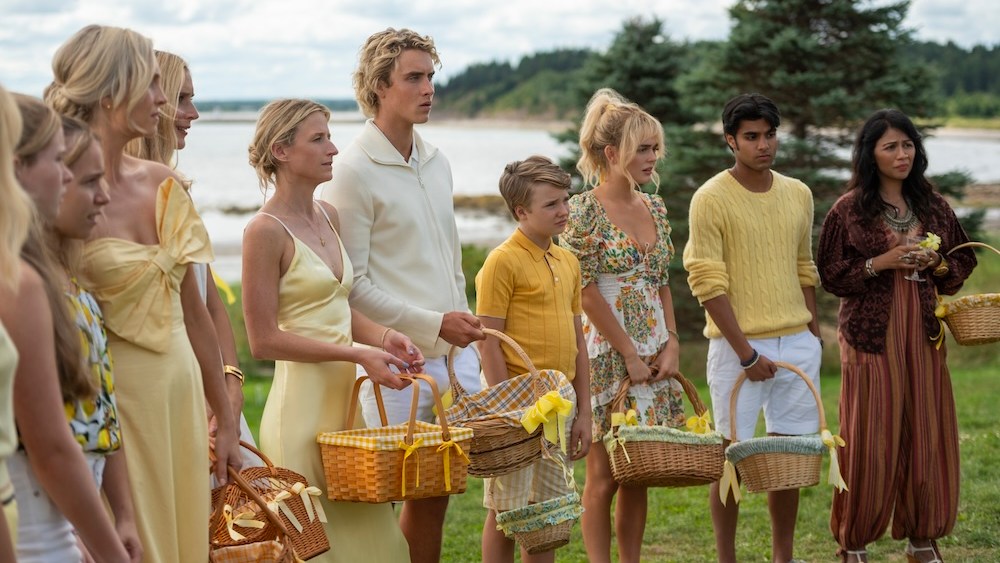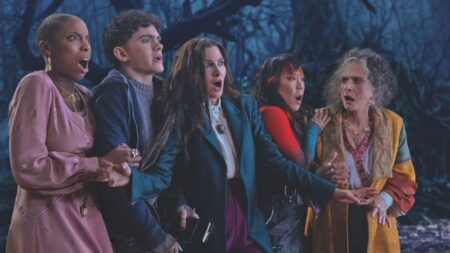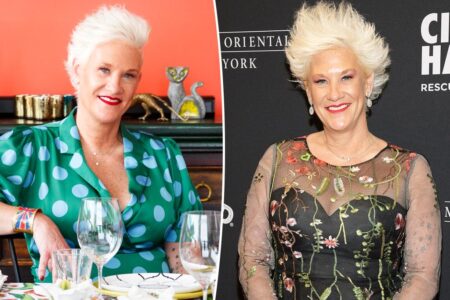SPOILER ALERT: This article contains spoilers for Season 1 of “We Were Liars,” now streaming on Prime Video.
Adapting a beloved book isn’t an easy task — and it took Julie Plec and Carina Adly MacKenzie many years to secure the rights for E. Lockhart’s bestseller “We Were Liars.” Together, the co-showrunners worked with Lockhart to transform her YA novel into the eight-episode series about the teenage members of the privileged Sinclair family (Cadence, Johnny, Mirren and Gat) — dubbed “The Liars” — over the course of two summers.
The series begins with Cadence (Emily Alyn Lind) washed up on a beach, barely clothed, at the end of summer 16. The last things she remembers are from earlier that summer, such as sharing the perfect kiss with family friend Gat (Shubham Maheshwari) and spending time with the Liars. Throughout the series, Cadence, now in summer 17, attempts to figure out what happened to her the summer before that landed her in the hospital with a traumatic head injury, and why no one visited her after the accident.
The story, while unfolding as a YA drama of summer love, has a deeper theme about privilege as the Sinclair family, specifically the liars’ grandfather, Harris (David Morse), and their mothers Carrie (Mamie Gummer), Penny (Caitlin Fitzgerald) and Bess (Candice King) are full of secrets.
The finale, written by Lockhart, unveils most of the secrets: At the end of summer 16, the Liars burned down their family home as an act of protest, and everyone died except for Cadence (it had been her idea). Throughout the series, she’d been seeing the Liars as if they were still alive but really were figments of her imagination. Or were they ghosts?
Jessie Redmond
Below, Plec, MacKenzie and Lockhart break down the adaptation’s book-to-show changes, the ending and what future seasons could look like.
Let’s start at the end. What were the early conversations about how to craft the twist and ending?
Carina Adly MacKenzie: We had a lot of conversations about where to reveal that there was a fire, then we built backwards from that. I talk a lot about how much I hate eight-episode seasons. I’d love to do 20 of these, but when you only have eight, you have to go about it a little bit mathematically.
Julie Plec: Personally, it was important to me that we did not start to reveal the trauma and then stop and cliffhanger it. I really wanted to capture the ugly cry from the book. And you can’t have an ugly cry if you are hit with the shock and then cut to commercial. You really need to go on that whole roller coaster. Neither of us are mystery writers, but we are fans of the genre, and you understand that when you have a whodunit, you have to put in your suspects, your red herrings, to show motive, and you have to take the audience on the journey. So what we really wanted to do was use the dogs as the thing, so that the audience would be like, “Oh my God, not only did they burn the house down” — which we told you in the previous episode — “but they killed the dogs.”
E. Lockhart, how much were you involved in the conversations?
E. Lockhart: Julie and Carina were very open to having conversations with me. I was there for a 10-week development room and when I was writing the finale, I came in for two weeks. But, I also visited for two weeks before that on Zoom to understand what they were doing for Episode 7. I felt very invited into the process.
MacKenzie: We had to cut things, we had to add things. Emily knew where the load-bearing things were, what we couldn’t pull out because this thing would fall. In another world, with her not in the room, we wouldn’t know things would fall until four days later.
Lockhart: Occasionally, I would say that something was important to my readers. An example is the writing on the hands. You could completely cut it, and it would not hurt the essence of the story. But, it is threaded throughout, and people come to events for the novel with writing on their hands. So I knew this was important to my core readers. They very quickly put it back in. I did not realize that’s not an easy thing to film. Temporary tattoos on their hands, and they have to be exactly the same day after day.
MacKenzie: And then the sand would get stuck on the temporary tattoo! But I wanted it too. The thing that Emily has is a lot of face-to-face time with her readers. Our audience has imagined it, but we have her readers and little things that were important that we got to Easter Egg in there.
Carina, this has been a big passion project for you. Were there things you really wanted?
MacKenzie: Yep, and a lot of them were cut. There’s a ton of stuff in the book that was important to me. The one thing that I sort of found myself continuing to go back to is that the rhythm and the language of the book is very specific. It doesn’t necessarily lend itself to dialogue, so in the voiceover, we had the opportunity to touch back into poetry and capture that feeling. We’ve been working on this show for a lot of years. There was one thing from the book at the beginning. I was like, over my dead body [will this get cut]. This has to be the way the show opens. This has to be the opening scene.
It’s not?
MacKenzie [shakes head]: That’s the process. I mean, the reality is I really do hope and believe that lovers of the book are gonna love the show. I also would love to tell them that if they’re sad, something’s gone, I am also sad that it’s gone.
Plec: The horrors that wake me up in the middle of the night are the changes that we were asked to make from the very beginning, that we accepted that early in the process were fine, and then built the entire story from it. It’s those things that terrify me, that people will say, “Well, why did you do that?” Because we hadn’t even thought about that decision since before we even wrote the scripts. It’s the foundational stuff, like one particular case is collapsing timelines of summer 14 and summer 15.
Lockhart: I don’t even notice that. Three timelines would have been so confusing. That was definitely a very good choice.
The hair changes are also so great and helpful.
Plec: We bit off a lot more than perhaps we meant to, but it was really important to us that we didn’t have to resort to cheesy trophy visual cues to differentiate the two timelines. We didn’t want one timeline to be amber and one timeline to be blue. I feel like that is something that I always cringe a little bit at.

Jessie Redmond
It wasn’t just Cadence’s dark hair, but also Mirren (Esther McGregor)’s short hair.
MacKenzie: She auditioned for us with short, cool, edgy hair. By the time we chose her, she had that long hair. And we then said, “Can we cut your real hair back into the short, edgy one, but we’re going to make you a wig that is exactly like this hairstyle that you have with the longer hair? Because that also looks good on you, but we need the wig to not be the short one.” So both of those looks were very fitting of Esther, but the short, edgy one is Mirren after she’s kind of decided she doesn’t want to be her mom.
Plec: Scripting in the moment where she cuts her hair was Carina’s idea, and it made it all work.
There are very strong themes of racism, class and privilege in the book — and I’d say they’re even stronger in the show. Why was that so important for you guys and how did you make sure it was authentic?
Plec: There is no business for the show to be made today, in this time, with this cast of beautiful, rich, wealthy, white people, if it’s not about the perils of entitlement and privilege and without exploring the issues of class. So that was hugely important to us.
Lockhart: They did something that I could never have done. They had a writers’ room with four writers of Indian descent writing episodes and contributing to the overall story arc. And those writers were incredibly excellent television writers with comedy, drama and thriller skills. They were also bringing their lived experience to flesh out Gat and Ed’s characters and to make sure that those storylines were bigger and more nuanced than anything that I could have written. And so I felt really lucky that it was expanded that way.
Plec: There’s this one example: We were talking about Gat’s complicity in burning the house down, because Gat is such a great character. He makes mistakes, he’s flawed but he’s a strong character. And it was sort of my question of, “But why would he help burn this place down? Maybe he doesn’t.” And it was our Indian writers specifically, who were like, “Don’t other him by making him better than everybody else. He’s going to want to do the thing that the other kids are doing because they’re his best friends, and he’s going to want to get into trouble with them. Even though yes, the consequence of him getting caught, we can explore, don’t make him so pure that he doesn’t get to take part in actually lighting a match.” They really felt very strongly about that. I thought that was such a cool example of when you hire writers who can tell the right stories for the characters in your script that don’t look like you, that is exactly how you get better realized characters. It’s just something we missed for a lot of decades in this business.
MacKenzie: We also had great conversations with Rahul [Kohli] and Shubham about a lot of little things to make it feel more authentic. We wrote the conversation that Gat has with the liars in Episode 7, where he says, “[Harris] knows me, he saw me run around through some fireflies, and he still hates me. Do you know how that feels?” That was from me talking to Shubham and being like, “What is left unsaid? We’re about to have the final, final finale draft. What hasn’t been expressed properly that you feel like we need?” We had a lot of help. Also, it was helpful that Cadence is someone who wants to learn, wants to be better, sees her own flaws and wants to fix them, and doesn’t always do a great job. We didn’t have to write a perfect white person standing up against racism. She’s not perfect. She makes a mess of things. We’re not trying to preach to anybody. Nobody in this entire story has clean hands. There’s levels of complicity, but everyone, including Ed and Gat, is a little bit complicit in what happens.
Plec: The dumbest thing in the world when you’re pissed off at your wealthy family for being shallow and racist is to burn down a generations-old family home with all of your most prized possessions in the name of being progressive. And it is so emblematic of, like, performance of allyship and all those things. That’s kind of what I love about it — these kids get one taste of a progressive instinct, and take it so far that they actually negate their own wisdom instantly, by being so privileged, they don’t even understand the inherent problem in what they do. And then they face the ultimate consequence for it.

Courtesy of Prime
There are three books in this series, with the third coming out in the fall. Do you see this as, ideally, a three-season show?
MacKenzie: The great thing about this show is that the first season has a satisfying, powerful ending. So I want people who generally don’t tune in to the first season because they’re afraid it’s going to get canceled, to know that they’re safe to watch this show, and if it doesn’t get a second season, you’ve still got a whole story. But also, Emily wrote three books and we love this world. We love our cast. We’d love the opportunity that exists for more story, so we’re hopeful that we’ll get to come back and do more. But also, should this be a limited series, I think it’s a beautiful story.
Plec: I think when Emily wrote the prequel, it unlocked in my brain the realization that this wasn’t just a single young woman’s journey, that this is a multi-generational fantasy on an island that has generations of drama and secrets. So I think our goal would be, as we move to subsequent seasons, to continue to build out the world and the bloodline and the stories of the past. Who are the Sinclairs, and how did they become this way? And so as we continue to move the story forward, we’ll have to keep taking beats backwards to see what made them who they are.
So, would Season 2 ideally be the direct prequel of who the mothers were at 16, as Beth hints at in the end?
MacKenzie: Depends who you talk to.
Plec: Ideally!
Are you all on the same page?
MacKenzie: We are all on the same page. One of our big goals in the adaptation and the changes that we made was to make these women so fun to watch. They are the villains, in a lot of ways, of this story, but we wanted you to want to know them, and I think we really accomplished that. I’m really proud of those mom characters. I think it is, unfortunately, a rarity that the moms in YA storytelling get to be nuanced, fucked up, messy people. In a lot of YA stories, you see what it feels like for a kid to realize their parent isn’t perfect. We also wanted to tell the other side of the story: How does it feel as a parent when you realize your kid realizes that you’re not perfect? And what that tension was between all the characters and the mothers. We loved writing those women, and I want to know how they became those women.
One of my favorite moments of the mother-daughter storylines is after Bess and Mirren’s huge fight, Bess talks to her daughter, but she never apologizes.
MacKenzie: I learned everything I know about stories from Julie, but Julie has an instinct toward a happy ending that I do not have. I want tragedy and questions, and I want unresolved shit, because when your kid dies in the fire, you didn’t resolve everything before. So there was a little bit of a like, should we have them have a nice moment? What do the last moments between the moms and their kids look like? I pushed really hard to say, “Don’t resolve it.”
Plec: The heartbreak that this is literally the last moment they did have, and none of it was good, none of it was pretty, that sits with those women. And it’s going to traumatize them.
Well, you could visit that timeline too — the summer after the kids are gone and how the mothers handle it.
MacKenzie: We love our mom characters in the present day. We obviously love our three actresses as well as the Liars, and so the intention is not to just tell a prequel. The intention is to move the story forward with those actresses and hopefully get to delve into them in different ways.
Plec: We also love the littles! Season 4, they’d be about the right age to be the new liars.
Can we talk about Carrie seeing Johnny (Joseph Zada) in the end? What did that mean, and why did you add that in?
MacKenzie: Well, because we wanted to make sure we locked Jojo in for Season 2 so he couldn’t run off and get any gigantic blockbuster movie franchise roles and abandon us forever! Just kidding, I’m the most excited for Haymitch. Throughout the first season, if you pay really close attention to Carrie in summer 17, there are some eccentricities that go unexplained until you realize she’s been seeing Johnny too.
Carrie and Cadence have a lot in common. They are sensitive women in a family where sensitivity is shunned, they have experienced major trauma, they both have battled levels of addiction. After reading the novel, I had this lingering question: Were the ghosts real or was Cadence’s traumatized brain lying to her to help her cope with the tragedy? I hope the audience is asking that, too. The version of Johnny that Carrie sees, if you really pay attention, is a little different from the version that Cadence sees. Carrie’s Johnny is looking rough. He’s sitting in the same spot, wearing the same thing that he was when his mother last saw him alive. So the question is this: Is Beechwood Island supernaturally haunted? Or is this a shared symptom of some kind of hereditary mental illness? Hopefully, we’ll get a Season 2, and the debate in the writers’ room will continue.
Plec: The final scene actually echoes the opening of the second book in E. Lockhart’s series, “Family of Liars.” It’s meant to tell the audience that there is, indeed, so much more story to come in future seasons. It serves to continue the question of whether or not Beechwood is cursed or if perhaps mental illness afflicts many generations of Sinclairs.
This interview has been edited and condensed.
Read the full article here








